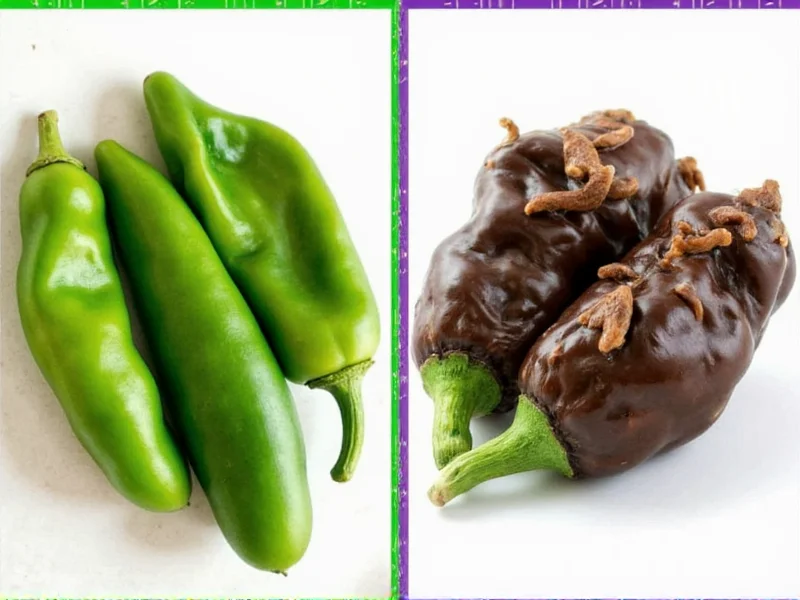Understanding the difference between chile poblano vs chile pasilla is essential for authentic Mexican cooking. Many home cooks struggle with these peppers due to inconsistent labeling and regional naming variations. This comprehensive guide clarifies the key distinctions to help you select the right pepper for your recipes.
Visual Identification: Telling Poblano and Pasilla Peppers Apart
Proper identification starts with understanding what you're actually looking at. The confusion between chile poblano and chile pasilla largely stems from inconsistent terminology across different regions and markets.
Fresh poblano peppers are large (3-6 inches long), broad, heart-shaped peppers with thick walls. They mature from dark green to red, though most are sold while still green. When dried, poblanos transform into anchos—flatter, reddish-brown peppers with a distinctive heart shape.
True pasilla peppers don't exist in fresh form in most markets. What's labeled “pasilla” is actually the dried form of the chilaca pepper. Fresh chilacas are long (6-8 inches), narrow, dark green to brown peppers that become dark brown to black, wrinkled pasillas when dried. Many US grocery stores mistakenly label fresh poblanos as “pasillas,” adding to the confusion.
| Characteristic | Chile Poblano (Fresh) | Chile Pasilla (Dried Chilaca) |
|---|---|---|
| Shape | Large, heart-shaped, wide | Narrow, long, wrinkled |
| Color (Fresh) | Dark green | Dark green to brown (as chilaca) |
| Color (Dried) | Brownish-red (Ancho) | Dark brown to black |
| Heat Level | Mild (1,000-2,000 SHU) | Mild to medium (1,000-2,500 SHU) |
| Flavor Profile | Earthy, slightly sweet, grassy | Fruity, berry-like, smoky, raisin notes |
| Common Uses | Stuffed peppers, rajas, light moles | Complex moles, adobo sauces, salsas |
Flavor and Heat Comparison
When examining chile poblano vs chile pasilla heat level and flavor, notable differences emerge that affect recipe outcomes. Poblanos offer a mild, earthy flavor with subtle sweetness and grassy notes. Their heat registers between 1,000-2,000 Scoville Heat Units (SHU), making them accessible even for those sensitive to spice.
Pasillas provide a more complex flavor profile with distinct fruitiness, berry notes, and subtle smokiness. Their heat ranges from 1,000-2,500 SHU—slightly hotter than poblanos but still considered mild. The dried pasilla develops rich, raisin-like undertones that deepen when toasted or rehydrated.
Understanding these flavor differences between fresh poblano and pasilla peppers is crucial when following authentic Mexican recipes. Substituting one for the other can significantly alter the dish's character, especially in complex sauces like moles where specific pepper combinations create signature flavors.
Culinary Applications and Substitutions
The best uses for poblano peppers include chiles rellenos (stuffed peppers), rajas con crema (sliced peppers in cream sauce), and lighter mole varieties. Their thick walls hold up well to roasting, peeling, and stuffing. When dried as anchos, they contribute earthy depth to moles and adobos.
Pasilla peppers shine in traditional mole negro, complex adobo sauces, and rich salsas where their distinctive fruitiness enhances complexity. Their narrow shape makes them less suitable for stuffing but ideal for grinding into sauces. Many authentic Oaxacan and Pueblan recipes specifically call for pasilla to achieve authentic flavor profiles.
When considering can I substitute pasilla for poblano, the answer depends on the recipe. For fresh pepper applications like stuffed peppers, bell peppers make a better substitute for poblanos than pasillas. For dried pepper applications, ancho (dried poblano) can sometimes substitute for pasilla in moles, but the flavor profile will differ. As a general rule, use 1 teaspoon of ground dried pepper for each fresh pepper called for in a recipe.
Availability and Forms
Finding authentic chile poblano vs chile pasilla depends on your location and the season. Fresh poblanos are widely available in US grocery stores year-round, particularly in regions with significant Mexican populations. They're typically sold in the fresh produce section.
True pasilla peppers (dried chilacas) are less consistently available. Look for them in the dried chili section of Mexican markets or specialty grocery stores. Be cautious of mislabeling—many stores incorrectly label dried poblanos (anchos) as “pasillas.” Authentic pasillas should be narrow, dark brown to black, and deeply wrinkled.
Understanding regional naming differences helps avoid confusion. In Mexico, “pasilla” specifically means “little raisin” and refers only to dried chilacas. The term “ancho” describes dried poblanos. In the US, inconsistent labeling has created significant confusion between these peppers.
Practical Tips for Home Cooks
When selecting fresh poblano peppers, look for firm, glossy skins without wrinkles or soft spots. Larger poblanos often have thinner walls and more seeds, while smaller ones may be hotter. For dried peppers like pasilla, choose those with deep color and flexible texture—brittle peppers indicate age and diminished flavor.
Proper preparation differs between these peppers. For fresh poblanos, roasting and peeling enhances flavor and texture. For dried pasillas, rehydration in hot water for 15-20 minutes followed by toasting in a dry skillet maximizes flavor before incorporating into sauces.
Storage recommendations vary: fresh poblanos keep for 2-3 weeks in the refrigerator's crisper drawer, while dried pasillas maintain quality for 6-12 months when stored in airtight containers away from light and moisture. Freezing roasted, peeled poblanos preserves them for up to 6 months.
Common Questions Answered
Understanding the nuances between chile poblano and chile pasilla prevents recipe failures and shopping confusion. These peppers play distinct roles in Mexican cuisine, and recognizing their differences elevates your cooking accuracy.











 浙公网安备
33010002000092号
浙公网安备
33010002000092号 浙B2-20120091-4
浙B2-20120091-4